
The market continues to bleed as if there is no tomorrow. FIIs (Foreign Institutional Investors) continue to sell on a daily basis, and the markets are taking a back seat on a day-to-day basis. While the markets have become oversold to some extent, there’s still more room for further downside, which we are likely to see soon. Starting this Sunday, we will be launching a new series called Momentum Misfits. We will discuss stocks that are out of momentum, and if they’re part of your portfolio, you may want to reconsider holding onto them.
Today’s topic focuses on a dangerous decision trap that many investors fall into, and we’ll discuss this in more detail in the second half of the video
Where is the market headed?
Market Overview
While we moved down by 0.69% today, we are still within the same range we have been for the past month or so. Although we recovered a bit yesterday, today we couldn’t sustain that recovery. There’s a chance we are at a tipping point where just one more bad piece of news could push us down further, potentially to 23,250 or even lower. On a more positional level, we have started to see some results trickle in, and GDP numbers are already out. There are expectations around the budget, but nothing concrete yet. Donald Trump has already outlined what he plans to do, so if things don’t turn out to be as pessimistic as they seemed earlier (like with tariffs or potential tax cuts), the market could swing back.
Until then, however, the lethargic and listless move in the markets continues, and the FII selling may not stop just yet. A study we conducted (though not part of this video) shows that, on a dollar-terms basis, Nifty has only returned about 12% in the past three years, compared to a 36% return on the S&P 500. Given this backdrop, global investors may reconsider their exposure to India, which has only returned 12% over the last three years. If you, as an investor, had to choose between two options — one delivering 12% returns and the other delivering 36% — you would probably look to move away from the 12% option. This explains a large part of the FII selling, but I believe much of that money will come back once the momentum swings in an upward direction.
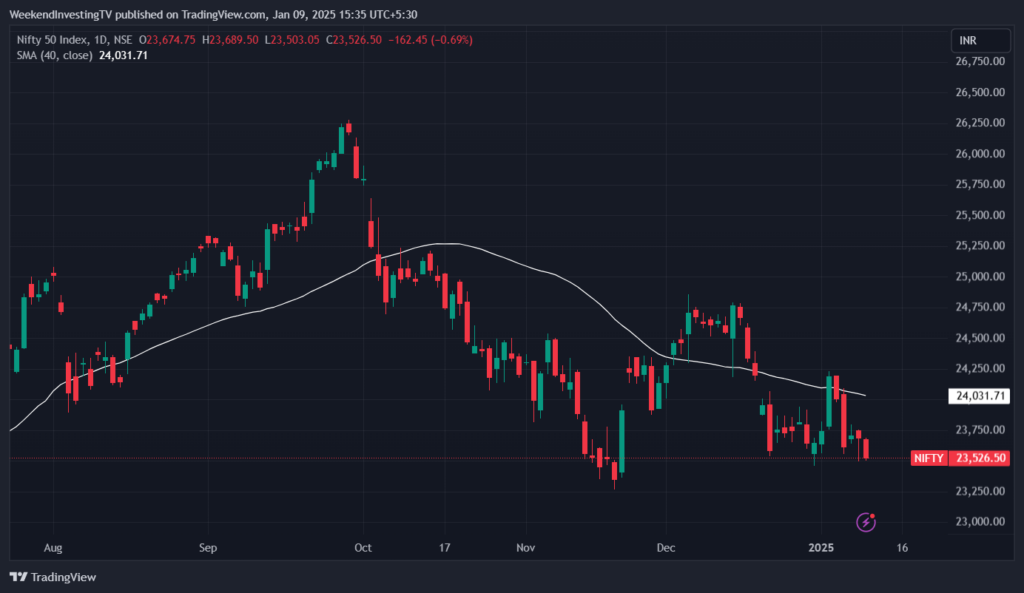
Nifty Next 50
Meanwhile, Nifty Jr. (Nifty Next 50) has absolutely lost momentum, falling 1.27%. This has broken recent supports and is now on a five-day downward streak. It has dropped from 78,000 to nearly 65,000, approaching a 20% drawdown.
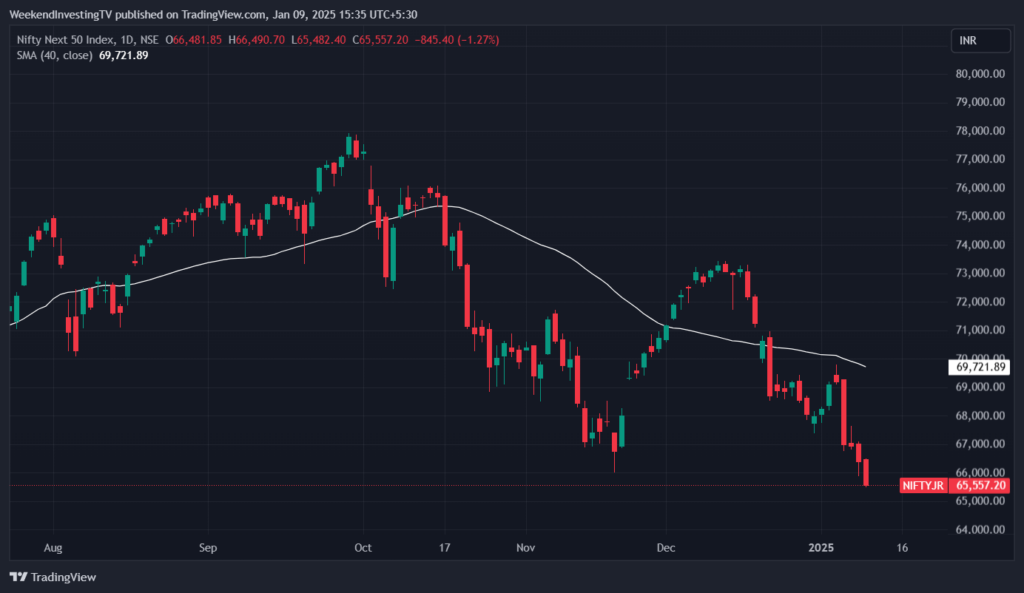
Nifty Mid and Small Cap
The mid-caps also lost 0.8%, and this gap is likely to be filled, although the recent lows are still quite far away. Small caps have lost 1.17% and are near a support zone established in November. All charts are currently looking quite weak.
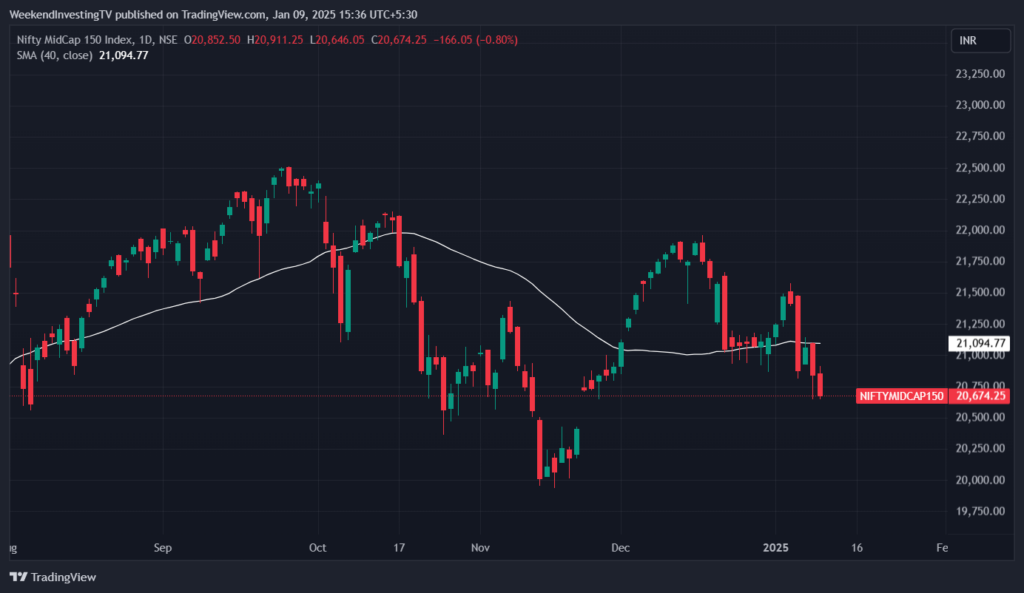
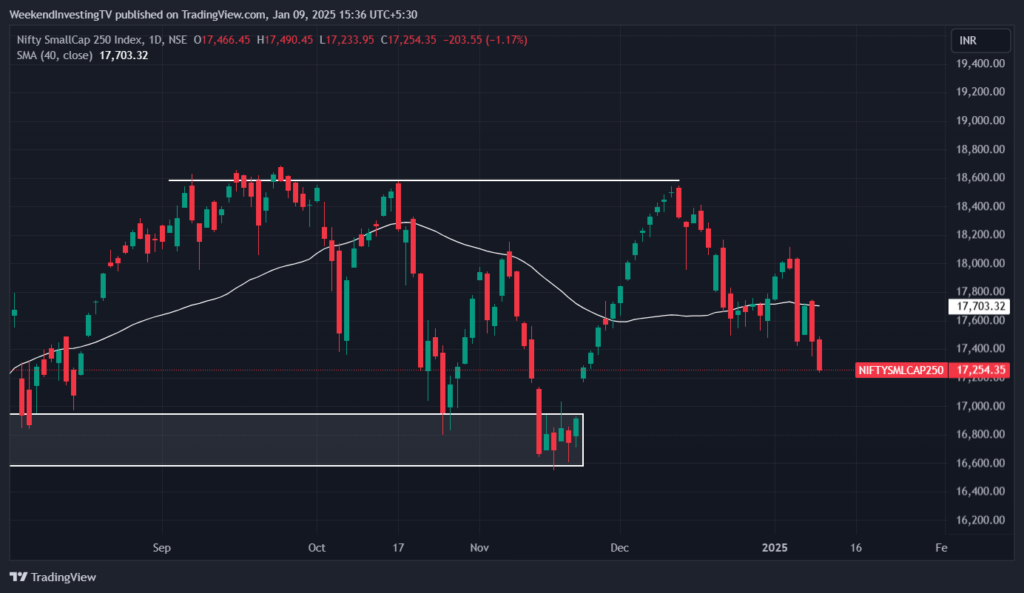
Nifty Bank Overview
Bank Nifty also broke down below its support levels. Although there were two long wicks on the last two candles, indicating some attempts at recovery, so far, those attempts have been elusive, with Bank Nifty down by 0.67%.
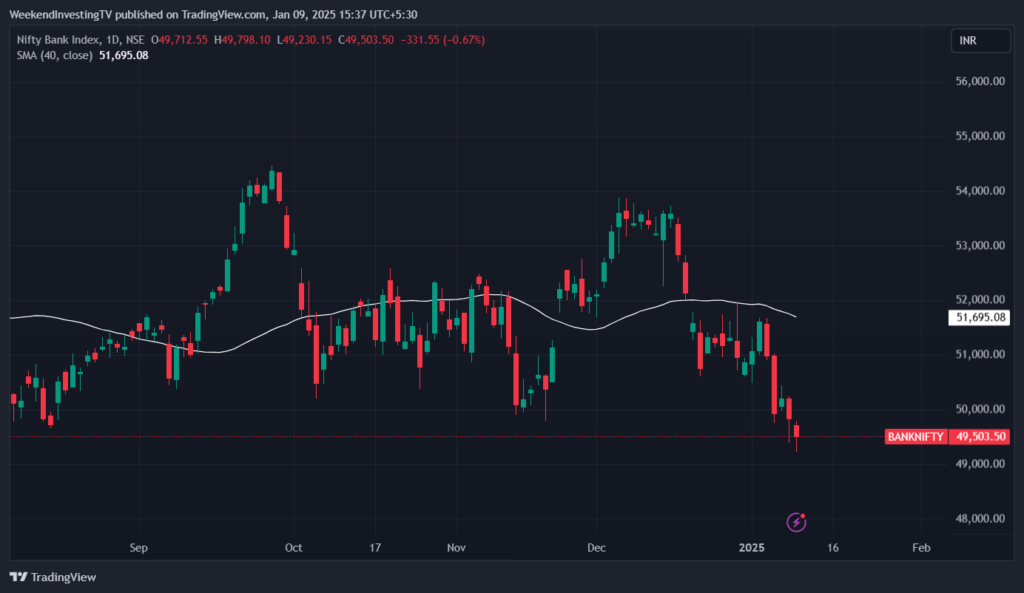
Advanced Declined Ratio Trends
Out of the top 500 stocks, 367 declined while only 130 advanced, so the bias was overwhelmingly towards the red.

Nifty Heatmap
HDFC Bank is falling almost every day, while TCS dropped 1.69% ahead of its results today. ONGC broke down after a few good days, falling 3%. On the flip side, some FMCG stocks showed a bit of green, such as Hindustan Unilever, ITC, Nestle, and Tata Consumers, but the broader market remained weak.
In the auto sector, Tata Motors and Maruti were down, though Bajaj Auto was one of the few stocks in green. Infra stocks were also down, with L&T losing nearly 2% and Adani Ports down 1.7%. Most stocks across the board were hammered today, with Nifty Next 50 also predominantly in the red, although stocks like Zydus Life, PD Lite, and Godrej CP were among the few with some green. Vedanta, Zomato, ABB, DLF, PFC, Geofinance, LIC, JSW Energy, and Gas Authority were among the many stocks losing ground. Even Naukri took a significant hit in today’s session.
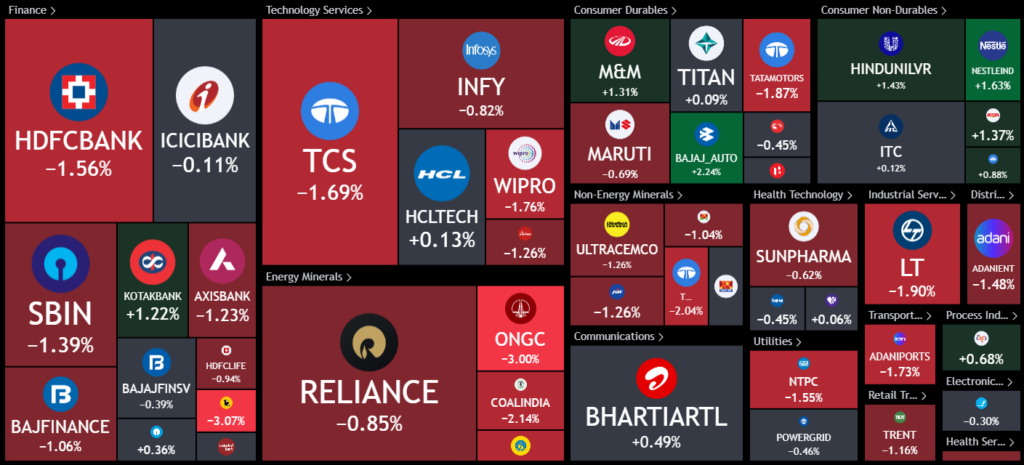
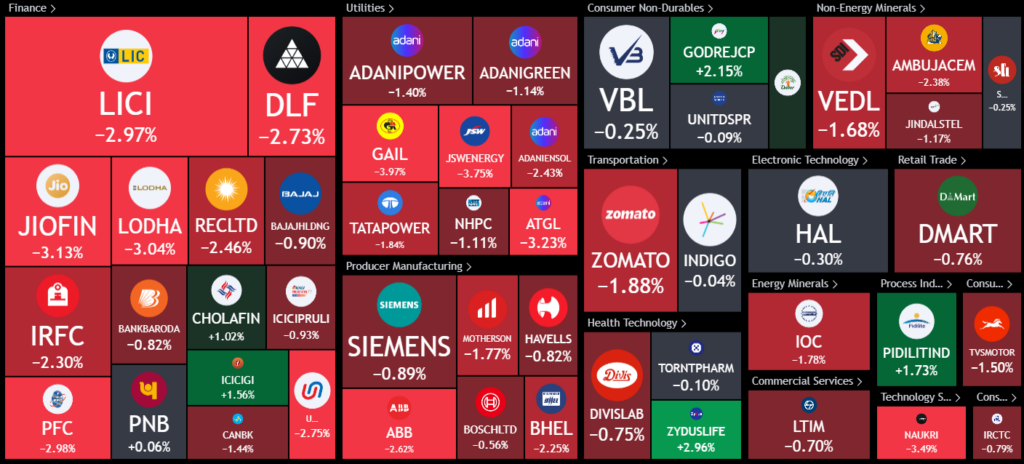
Sectoral Overview
Sector trends were mostly negative, with FMCG eking out a small 0.9% gain. While FMCG has seen flat performance recently, which is not necessarily bad news from a valuation perspective (since many FMCG stocks are considered richly valued), it seems the market is okay with this level for now. Other sectors like autos, pharma, real estate, energy, public sector enterprises, metals, and IT all saw significant declines. Real estate and energy stocks were particularly hard hit. Even commodities fell 1.1%, and infra stocks dropped 1.2%. Overall, it was a red day across the board, with only a few consumption and FMCG stocks receiving some buying interest.
Looking back over the past week and month, there hasn’t been much good news from any sector, though pharma and FMCG showed some minor gains. As a whole, it’s been a mostly red market.
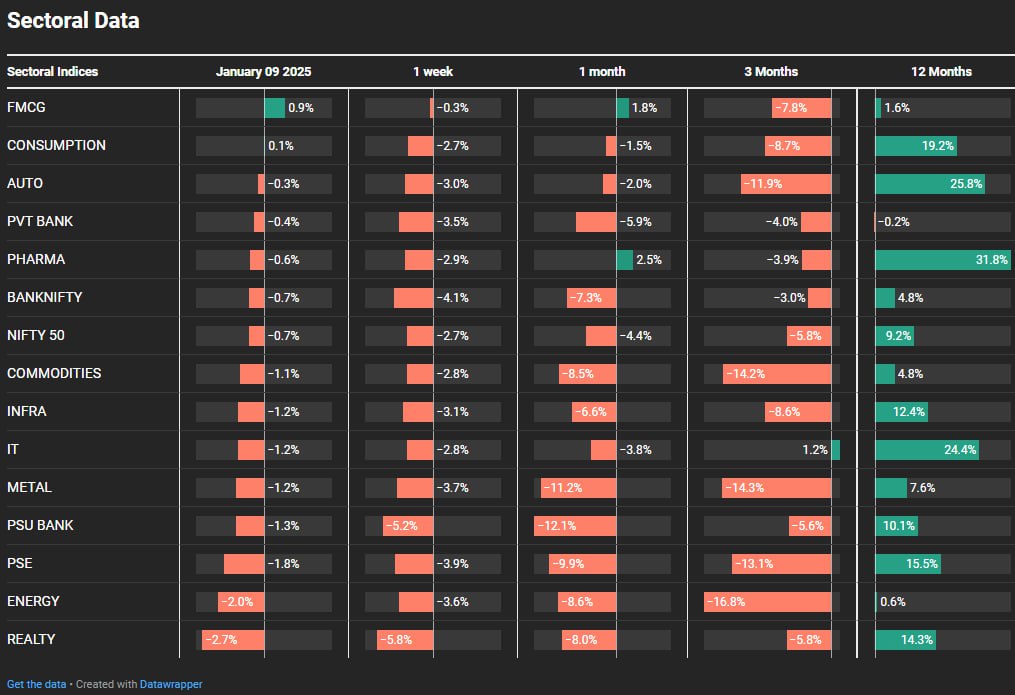
Sectors of the Day
Nifty FMCG Index
The FMCG sector saw some good gains from stocks like Marico, Colgate, Pamulev, Godrej Consumer, and Nestle.
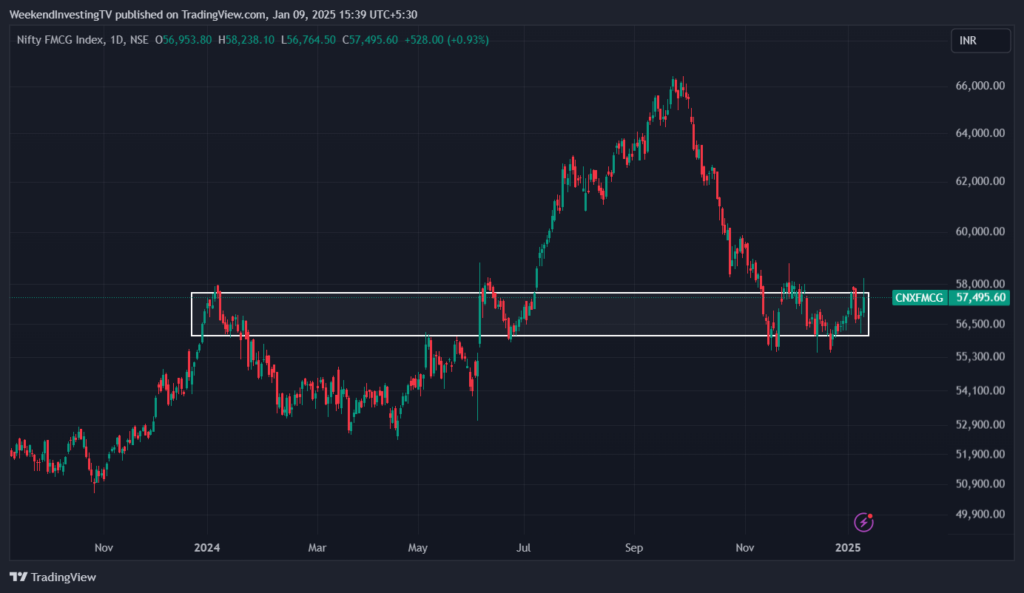
Story of the Day : The stock decision trap
Many investors fall into this mental trap, where they become too attached to a stock and end up holding it for too long, even when it underperforms. We’ll take Reliance as an example, which is one of the most popular stocks in the market. Reliance has been a standout performer over the long term, with a CAGR of 17% since 1991. However, there have been periods when Reliance underperformed significantly. From 2008 to 2018, Reliance had a decade of negative returns, and from 2000 to 2004, there was another five-year stretch of underperformance.
Right now, we are in another slow phase for Reliance. From April 2022 to January 2025, Reliance has stayed flat, while the Nifty index itself has gone up by almost 38%. If you were holding only Reliance during this period, you’d probably feel quite left out. Since Reliance is such a large part of the Nifty, accounting for 9% of the index weight, its stagnant performance has also affected the Nifty’s overall growth. However, other stocks have helped drive the Nifty’s 37% rise over the past three years.
Looking at the last six months, one year, and three years, there are many stocks in the Nifty that have significantly outperformed Reliance. In the last six months, stocks like HCL Tech, Trent, Sun Pharma, Apollo, Infosys, Tech Mahindra, Wipro, ITC, Bharti, and Dr. Reddy have done very well. Over the past year, stocks like Trent, Mahindra, Bharat Electronics, Bharti Airtel, Sun Pharma, and Shriram Finance have delivered solid returns. Over the last three years, Trent has given a 510% return, while stocks like BEL (305%), Mahindra (276%), Bajaj Auto, NTPC, Coal, Shriram Finance, Bharti Airtel, Sun Pharma, and ITC have all outperformed Reliance.
In fact, out of the 50 stocks in the Nifty, 43 have outperformed Reliance over the past three years, 40 have outperformed in the last one year, and 47 have outperformed in the last six months. This highlights the underperformance of Reliance over recent periods. Recently, the stock dropped 25% in just six months.
The media has pointed out several reasons for this underperformance, such as rising debt, pressure on margins (especially in the oil business), and the cyclicality of the stock. Buy-and-hold investors often hold out hope that these challenges will eventually go away. However, there’s an opportunity cost to holding a stagnant stock for years while the rest of the market moves on. If you’re holding onto a stock that’s not going anywhere for five years, you are missing out on other opportunities where your money could be working harder for you.
When you hold onto a stock that’s been stagnant for years, even when it finally starts to move, you might not be able to capture the full potential of those gains. This is a common trap that many investors fall into. For example, from 2008 to 2017, Reliance spent nearly nine years getting back to its previous highs. During this period, it had collapsed 60% and took nearly eight years to recover, while the rest of the market saw a 60% gain. In this scenario, holding onto Reliance meant you were effectively losing ground to the broader market.
It’s also important to consider that stocks can remain flat for long periods, and it’s not always wise to hold onto them out of loyalty or nostalgia. If the stock isn’t moving, there’s no reason to stay married to it. Price action will eventually tell you when the stock is ready to move again, and it’s best to follow those signals rather than relying on outdated or irrelevant information.
The momentum approach to investing suggests that rather than fixating on reasons for a stock’s performance (or lack thereof), you should follow the price action. The price is the most accurate reflection of market sentiment and momentum, and it gives you a much clearer view of what’s happening right now, not in the past. When you buy based on momentum, you have a clear entry and exit plan, and you can execute without the ambiguity of second-guessing whether to hold or sell.
In today’s fast-changing market, the “buy and hold” strategy that worked in the past may not be as effective. With disruption happening across industries and markets, it’s important to focus on momentum and price movements rather than holding on to underperforming stocks for the long term. As markets evolve, your approach to investing should evolve as well.
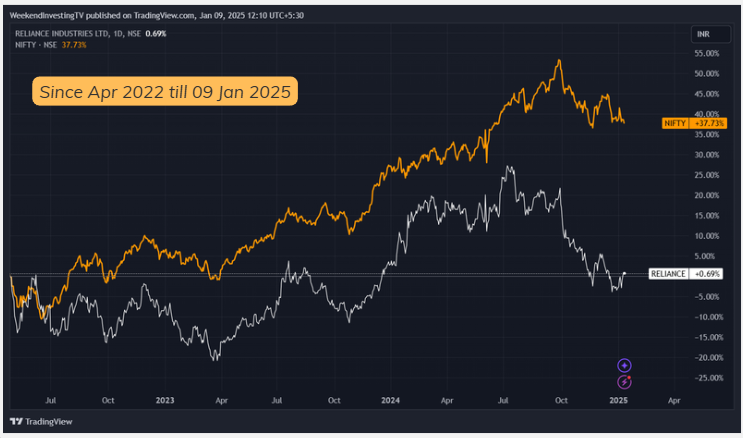
WeekendInvesting launches – PortfolioMomentum Report
Disclaimers and disclosures : https://tinyurl.com/2763eyaz






